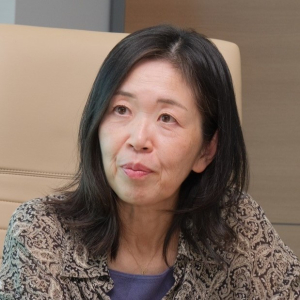
Is the Digital Transformation of Education a Realistic, Sensible Goal?
February 17, 2022
R-2021-042E
Spurred by the pandemic, the Japanese government has finally delivered on its commitment to equip each school with high-speed connectivity and each schoolchild with a computer terminal. But the verdict is still out on the educational benefits of greater digitalization.
* * *
On January 7, 2022, the Japanese government released a Roadmap for the Utilization of Educational Data (hereafter, “Roadmap”), a 53-page document outlining an ambitious plan to harness information and communications technology to create “a society where anyone can learn in their own way, anytime, anywhere, with anyone.” The target year is 2030.
ICT has already made considerable inroads in Japanese schools, especially over the past two years. But the digitalization of education as envisioned by the Roadmap would not merely reconfigure the classroom but also radically change the role of the teacher, thus transforming school education as we know it. Is this a realistic and sensible goal?
In the following, I summarize the Roadmap’s stated aims, explain the history leading up to the initiative, and consider some of its implications for school education in Japan.
Painting a Digital Utopia
The Roadmap was drawn up by a team of experts representing four different government entities: the Digital Agency; the Ministry of Internal Affairs and Communications (MIC); the Ministry of Education, Culture, Sports, Science, and Technology (MEXT); and the Ministry of Economy, Trade, and Industry. Echoing the Basic Policy for Reforms toward the Realization of a Digital Society approved by the cabinet in December 2020, it embraces the lofty goal of advancing “people-centered digitization that leaves no one behind” to build “a society where people can use digital technology to choose the services best suited to their needs and realize their own diverse ideas of happiness.” Moreover, it positions the digitalization of education as the key to this broader social transformation.
The Roadmap’s scope is wide, extending to lifelong and recurrent education, but its focus is on the creation of a school learning environment that makes optimal use of digital technology to facilitate a shift from the teacher-centered, lockstep “chalk and talk” mode of instruction to a more personalized, interactive, and self-directed learning experience.
The Roadmap makes its case for digitalization with the aid of colorful presentation-style graphics. For example, pages 7 and 8 present a depiction of a typical Japanese school before and after digitalization. At the center of the “as is” page is the cartoon image of a male instructor in front of his blackboard. Callout boxes label the teacher’s teaching style as “lockstep chalk & talk” and highlight the need to write things over and over again on the blackboard. Nearby scenes and captions stress the time and labor involved in preparing lessons and in marking and grading homework and tests by hand. Still others point out the burden of repetitive administrative tasks, exacerbated by a failure to digitize forms and basic data.
Constrained by time and distance, teachers have few opportunities for interaction with outside experts. The students, for their part, spend most of their time absorbing the information contained in mountains of paper handouts instead of exchanging ideas with their peers. Furthermore, inadequate digitization of academic records and incompatible systems can hinder a smooth transition when a student switches schools.
On the next page, we see a depiction of the schooling situation “to be” after digitalization. The teacher in the center now uses a labor-saving digital whiteboard. Class preparation is less time-consuming, since teachers can easily locate and assemble the needed teaching materials online. Homework and tests can be graded electronically. The digitization of school and student data and a shift to online forms and surveys save teachers time, freeing them up for more meaningful interaction with students. ICT facilitates frequent exchange with outside professionals and experts, boosting teacher morale and motivation.
As chalk-and-talk instruction gives way, what emerges is the self-directed, individualized, dialogue-intensive “active learning” that MEXT has long advocated in its curriculum guidelines. In the classroom, they can use their computer tablets to answer questions or share their ideas in real time for a more collaborative learning experience. Each student’s performance and progress, from class participation, time spent on tasks, and Internet search history to test results, can be saved to an individual study log. This would allow teachers and parents to identify individual students’ special interests and strengths while quickly identifying needs and potential problems at school and at home.
Academic records can be instantly transferred from school to school in their entirety to minimize disruptions in a student’s education. They can even be accessed years later as a tool for lifelong education.
Comparison Chart Compiled from the Digitalization Roadmap
|
|
Today’s schools |
Digitalized schools (by about 2030) |
|
Teaching style |
“Chalk & talk” lockstep instruction |
Focus on self-directed learning and dialogue |
|
Children |
Class participation restricted mainly to oral response |
Tablets can be used to display students’ ideas and thought processes on digital whiteboard |
|
Ascertaining level of understanding takes time |
Study time and test results can be utilized instantly to enhance learning |
|
|
Limited opportunities for peer dialogue and exchange |
Responses and ideas can be shared in real time |
|
|
ICT used predominantly for gaming (at home) |
Opportunities for enrichment and diversified learning activities in or out of school |
|
|
Academic records of transfer students sent via hard copy or not at all |
Academic records transferred instantly, so new teachers know student’s strengths and weaknesses |
|
|
Academic records of graduating students not always transferred to new school |
Academic records transferred instantly in compatible format for smooth transition |
|
|
Graduates have access only to returned tests and report cards |
Graduates have access to complete study log, saved in their PDS,* for review at any time |
|
|
Opportunities for post-graduation learning limited |
Online learning tools facilitate recurrent education and visualization of outcomes |
|
|
Teachers |
Repetitive use of blackboard for lessons |
Monitor can display prepared materials instantly, saving time |
|
Preparation of paper-based teaching materials |
Quick online search and compilation of materials using metadata |
|
|
Laborious hand-scoring of homework and tests |
Automatic scoring gives teachers time for personalized feedback |
|
|
School-related data not digitized |
Data stored online, facilitating administrative tasks |
|
|
Very little integration of administrative and academic data |
Administrative and academic data integrated to enable personalized teaching |
|
|
Time and geographical constraints limit exchange with outside experts |
Increased opportunities to talk with outside experts boost morale and motivation |
|
|
Families |
Parents have no clear sense of child’s daily performance and behavior at school |
Parents can monitor child’s progress and problems and provide support as needed |
|
Schools, communities |
No means of sharing data among schools and local governments |
Standardized data used to develop evidence-based educational policies and teaching methods |
|
Schools in remote areas have limited contact with other schools |
ICT facilitates exchange and joint learning with schools around the country and the world |
|
|
Children and households potentially in need of support difficult to identify |
Sharing of data facilitates active outreach by local welfare offices, etc. |
|
|
Education services |
Students’ edtech data is deleted upon graduation |
Anonymized data used to improve services following graduation |
|
Data format differs from one service provider to another |
Standardized format and linkage with curriculum guideline codes facilitate coordination with schools |
*Personal Data Store, a secure system for storing and sharing confidential educational data.
A Brief History of Japan’s Edtech Policy
To a large degree, the digital infrastructure required for this revolution is already in place. The Roadmap would build on the achievements of the GIGA School Program, implemented in 2020, to lend each schoolchild and teacher in Japan with a computer terminal connected wirelessly to a wideband high-speed network. The program’s targets had been substantially achieved, the government reported in April 2021, at a total cost of ¥460 billion.
The origins of the “one student, one computer” concept go back all the way to the year 2000, when Prime Minister Yoshiro Mori unveiled his vision for “national rebirth through a Japanese IT revolution.” The Diet passed the Basic Act on the Formation of an Advanced Information and Telecommunications Network Society (popularly known as the IT Basic Act), and in 2001 the government released its e-Japan Strategy, which pledged to transform Japan into an IT superpower within five years.
Education and ICT policymakers got to work setting ambitious targets for digitalization of the nation’s schools. Discussions within the government continued despite lack of substantial progress, with the MIC launching a school digitalization pilot program with MEXT’s cooperation in 2010. Under this pilot, a total of 20 “model schools” around the country—10 elementary, 8 secondary, and 2 special-needs schools—were equipped the following year with high-speed wireless LAN, interactive whiteboards, and a computer tablet for every student.
The experiment was scrapped, however, after the Democratic Party of Japan came to power and launched a comprehensive review of budget programs. Experts interviewed during the review were generally critical of the initiative, noting that the project design did not allow for close coordination between the MIC and MEXT, hindering the setting of clear educational goals and the implementation of benefit analyses. Others pointed out that providing a computer for each schoolchild was simply too costly given the country’s fiscal constraints. And still others called for research and analysis to identify the real reasons for Japanese schools’ slow embrace of digital technology, rather than rushing to fill classrooms with ICT equipment. In the face of such criticisms, the decision was made to terminate the program in 2013. However, by then the Liberal Democratic Party was back in power. In June 2013, the cabinet of Prime Minister Shinzo Abe renewed the call to digitalize the school learning environment via universal network connectivity, computer terminals for all students, interactive whiteboards, and digital teaching materials.
Alarm over the slow and uneven progress toward digitalization led to approval of the nationally funded GIGA School Program in 2019. The intervention was driven by fear that Japanese schools were failing to prepare Japanese children to compete in the global economy. Then Education Minister Koichi Hagiuda articulated these concerns in a statement on the GIGA School Program issued on December 24, 2019:
“Computer terminals have become must-have items on a par with pencils and notebooks. The use of ICT has become routine in every part of our society, at work and at home. We cannot let our schools, which [are supposed to] equip our children with the skills to survive in the world and expand their horizons, to remain behind the times and behind the rest of the world.”
The program initially set a target of equipping 100% of public elementary and secondary schools with high-speed Internet access and one computer tablet per student by 2024. In the wake of the Abe cabinet’s abrupt decision to close the schools in February 2020 due to the COVID-19 pandemic, though, the government came under enormous pressure to accelerate the distribution of computers and the use of digital teaching materials so that students could continue their schooling from home.
Thanks to the pandemic, the long-cherished goal of “one child, one computer” has become a reality. Is digitalization ushering in the hoped-for changes?
No Need to Think?
It will take time to answer that question, but in the meantime, MEXT provides a curated glimpse into the learning environment of the future via its December 2019 promotional video for the GIGA School Program. Designed to demonstrate the benefits of the initiative to classroom education, the video features scenes from a model school, with an emphasis on student engagement, autonomy, and creativity.
After two children present their programming projects—one involving musical composition, another equipping an electric train set with an accident-prevention mechanism—the principal who provides a running commentary stresses the need to provide each student with a computer tablet or similar device in order to nurture this sort of computer literacy. Next comes a discussion of how the tablets facilitate a much-needed shift “from lockstep instruction to a 21st-century mode of learning.” With the help of the tablets, says the principal, teachers “can deliver educational content and teaching materials geared to each child . . . and provide instruction tailored to a variety of students.”
It is the next segment that stops one short. Here, a schoolgirl explains the benefits of tablet-based learning. “Without the tablet, you have to figure it all out in your own head. With the tablet, whenever you make a mistake, you immediately get an explanation, so you can progress step by step.” This observation seems to contradict the idea that computer tablets nurture creative thinking and problem-solving skills.
To be sure, the video opened with dazzling examples of hands-on project-based learning. But what role did the tablets play? One suspects that they provided the students with the ideas for their projects and detailed instructions for carrying them out. Unfortunately, materials like the video and the Roadmap are short on answers to such questions.
Perhaps the most crucial question is whether broader use of computers in the schools actually improves educational outcomes. As it turns out, the Organization for Economic Cooperation and Development has addressed this very question using data compiled in its Program for International Student Assessment (PISA), which periodically assesses the reading, math, and science skills of 15-year-old students in participating countries. The 2015 OECD publication Students, Computers, and Learning analyzed the relationship between countries’ investments in school ICT resources and learning outcomes among the 39 participating countries between 2003 and 2012. The report found that mathematics performance had generally deteriorated in countries that had increased the number of computers per student over the same period. Even with respect to online reading comprehension, students performed best in countries where computer use was limited to once or twice a week.
Overall, the report says, “PISA data show that for a given level of per capita GDP and after accounting for initial levels of performance, countries that have invested less in introducing computers in school have improved faster, on average, than countries that have invested more. Results are similar across reading, mathematics and science.” As one OECD official suggested, it is not about the digital tools so much as the way they are used.
This report received relatively little attention in Japan, perhaps because the skills of Japanese 15-year-olds did not decline. But I wonder whether we can afford to ignore such sobering data on computers and learning now that we have achieved our goal of a terminal for every student—especially in the light of the abovementioned schoolgirl’s comments in the promotional video.
The Changing Role of Teachers
With these reservations in mind, let us return to our assessment of the Roadmap’s plan for digitalizing education over the next five or ten years.
Of course, digitization in the narrow sense—replacement of outdated analogue media with digital systems, and so forth—is manifestly doable; indeed, it has already been done. Digital whiteboards have become standard classroom equipment. However, the real aim of the government’s school digitalization program is not the adoption of digital tools but the digital transformation of education itself. The summation on the last page of the Roadmap makes this clear: “Digital tools and data are merely a means to the end stated in our mission—the creation of “a society where anyone can learn in their own way, anytime, anywhere, with anyone.”
On the same page, we are told that the children of today will need certain basic competencies to succeed in the society of the future. Among these are “reading comprehension skills,” “the capacity to think for oneself and convey one’s ideas to others,” and the ability to “engage in dialogue and collaboration to arrive together at novel and workable solutions.” Certainly, these are important skills. The big question is whether tablet-based digitalized education is the best way to nurture them.
Before we can answer that question, we must understand how and why school education in Japan is falling short. This means analyzing the educational ecosystem of the school to understand how its various components function together. Certainly, a central focus of this analysis should be the role of the teachers, inasmuch as the digital transformation envisioned by the Roadmap would radically change that role. Indeed, those changes are already underway, as suggested by comments like the following (gathered from students and teachers at Japanese elementary schools where digital technology already plays an important role in the classroom).
“If you ask the teacher for help, you sometimes get scoffed at, but if you use the tablet, it will explain where you went wrong step by step.”—Elementary school student, Hino, Tokyo (Yomiuri Shimbun, December 17, 2008)
“The [tablet’s] AI drills provide more detailed explanations, so it’s easy to master the things you have trouble with.”—Sixth-grade student, Nagoya (Yomiuri Shimbun, December 16, 2020)
“The students each choose their preferred mode of learning independently, and the teacher supports them as an advisor.”—Elementary school principal, Nagoya (Yomiuri Shimbun, December 16, 2020)
Over the years, Japan has developed rigorous systems and standards governing teacher education, hiring, in-service training, and classroom practices. All of these systems and standards are predicated on a shared understanding of the purpose of school education in our society and the role of the teacher in school education. In charting our way forward, we must carefully reassess our achievements from a historical perspective before rushing headlong into the digital transformation of education.





